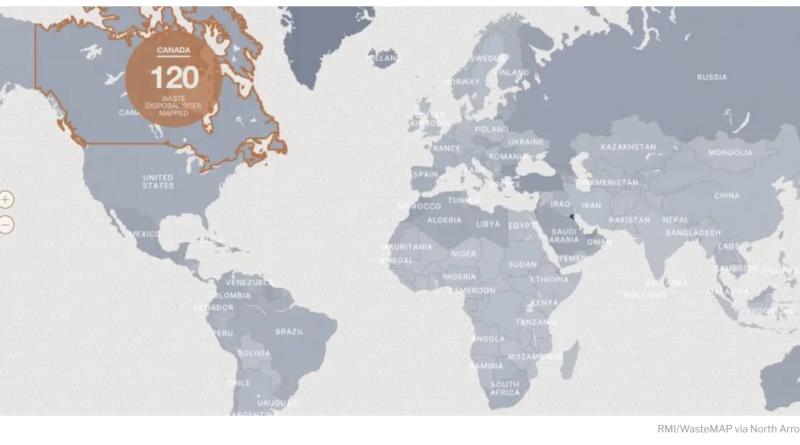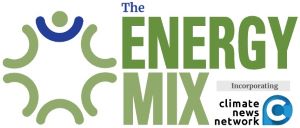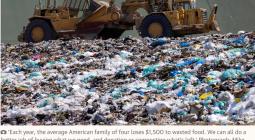Map of The Month: Landfill Emissions Tool Offers Methane Mitigation Strategies

The Energy Mix is partnering with mapmaking and visual storytelling experts at North Arrow to unveil a series of interactive maps that dig into climate change’s causes and effects, enriched with insights from experts.
As humanity faces a critical window to curb global warming, climate advocates turn their attention to methane, a greenhouse gas that has 84 times the impact of carbon dioxide over 20 years and contributes up to 30% of the rise in global temperatures.
Agriculture, fossil fuel production, and decomposition of human waste in landfills are known to be the largest methane sources, but experts caution that human waste emissions are usually underestimated: A study shows that landfills in the United States emit methane at levels at least 40% higher than reported, though in Canada, experts who measure emissions at landfills say the actual numbers are slightly lower than national estimates.
In 2020, landfills accounted for nearly a quarter (24%) of Canada’s methane emissions, making them not just a challenge, but an opportunity for effective climate action. The federal government has drafted a plan to regulate landfills, with a final version expected later in 2024. The plan proposes mandates for landfill gas recovery systems, methane destruction devices like enclosed flares, an engineered biosystem (like a biocover), or a landfill plan to reduce methane emissions by design. Last September, the federal government also committed C$575,000 in funding for five pilot projects to implement technologies that reduce landfill methane emissions.
For landfill municipalities planning their mitigation goals, RMI, formerly the Rocky Mountain Institute, has developed WasteMAP, a platform that integrates data from multiple sources to provide a clear view of local waste emissions. It draws quantitative data from Climate TRACE, satellite imagery from Carbon Mappers, and emissions estimates from entities like the United Nations Framework Convention on Climate Change and the Emissions Database for Global Atmospheric Research (EDGAR). Bringing these sources together creates an unprecedented level of detail and accuracy in emissions tracking at the country, city, and site levels, as shown above.
WasteMAP can serve as a planning and decision-making tool. It assesses site- or city-level waste management and presents mitigation strategies by modeling potential reduction outcomes, based on user-determined levels of investment in practices like basic waste segregation, incineration, recycling, and advanced anaerobic digestion techniques.
“Waste management is now recognized as a readily accessible area for quick wins in methane reduction,” Dr. Rose Wang, analytics and data science lead at RMI and a key figure behind WasteMAP, told North Arrow. Improved waste management has triple benefits.
“Not only can we significantly cut down emissions, but we also enhance the welfare of citizens by creating cleaner, more sustainable urban environments,” she said. “On top of that, captured landfill gas and biogas generated from diverted organic waste in enclosed anaerobic digester tanks can produce heat and electricity, helping cities diversify their energy mix and reduce dependency on fossil fuels.”
Walking the Talk in Canada
Despite Canada’s climate leadership aspirations, cities like Vancouver, Toronto, and Ottawa rank poorly compared to other cities in developed countries, with per capita landfill emissions exceeding some of their United States counterparts by more than 25%. WasteMAP data places them in the upper quartile of emissions per citizen, with Vancouver leading at more than 10.5 kilograms of methane per person annually, North Arrow analysis shows.
Vancouver’s ambitious Zero Waste 2040 initiative aims [pdf] to drastically reduce waste, but has struggled to meet its targets.
In 2019, when journalists at CBC Marketplace investigated how recycling worked in British Columbia, the province “known for having the most efficient recycling program in Canada,” only one of the three companies tested recycled the bales of plastic sent into the recycling stream. A second company burned it, while a third dumped it in a landfill.
In 2020, the city’s landfills received 305,000 tonnes of waste, missing the year’s reduction target by roughly 27%. “The continuous shortfall in meeting these goals raises questions about the effectiveness of current strategies and the feasibility of future targets,” writes North Arrow.
Last year, the city announced the decision to spend $150 million to transport excess trash to the inner provinces and even to neighbouring U.S. states. This illustrates one of the key challenges in methane emissions responsibility tracking, Wang said.
“It’s extremely hard to get accurate catchment areas for landfills,” she said. “Some cities might share one site or even sometimes ship their trash to other parts of the country, or even abroad.”
WasteMAP reports that today, just 12% of Vancouver’s waste is treated via composting. Its decision support tool finds that by treating 10% more with anaerobic digestion and 20% more via incineration, the city could curb 45% of its waste methane emissions by 2050.
“Reality is a bigger beast than simplified projections on a one-size-fits-all tool,” writes North Arrow. “But it’s a starting point for municipalities, and RMI’s hope is that with more local collaborations and more granular data, the model will improve.”
Indigenous Wisdom in Waste Management
As cities like Vancouver seek effective strategies to manage waste and reduce methane emissions, Indigenous waste management practices offer valuable insights. Indigenous communities excel in sustainable waste practices by tradition. Several were using circular economy principles long before they became a thing, emphasizing reuse and resource maximization to avoid waste. Techniques like zero-waste cooking, material repurposing, and communal resource sharing not only deal with the problem upstream but also foster a strong community bond and respect for the environment.
“Integrating these age-old practices through awareness campaigns could reduce the amount of waste produced and complement actions taken downstream, such as those being put in place by RMI,” writes North Arrow.
Enhancing Waste Management Globally
Waste management has transformative potential in growing urban centres, particularly in the developing world, said RMI’s Wang. “By implementing better waste management practices now, we can prevent significant methane emissions in the future.”
RMI runs a country engagement initiative to complement the WasteMAP tool, offering practical, on-the-ground strategies for improved waste management and methane reduction. Focused on some of the world’s fastest-growing urban areas, like Lagos, Nigeria, the RMI team brings its expertise directly to local officials and stakeholders. Their detailed playbooks allow cities to assess their waste management maturity and suggest steps for more effective emissions reduction.
“Our goal is to bring our scientific and financial expertise to places where it can make the biggest difference,” Wang said.





